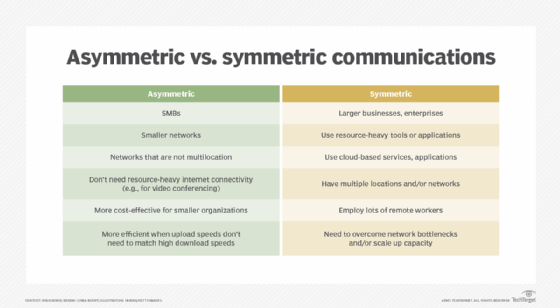asymmetric communications
What is asymmetric communications?
Asymmetric communications is a term pertaining to any system in which the data speed or quantity, when averaged over time, is different in one direction from the other. Sometimes referred to as asymmetrical or nonsymmetrical communications, asymmetric communications is the opposite of symmetric communications, in which data speed or quantity is the same in both directions over a certain period.
While symmetric communications yields the same upload and download speeds, this is not the case for asymmetric communications. Asymmetric speeds are often found in traditional internet connections in which download speeds often need to be significantly higher than upload speeds or in the wireless networking world, in which data is sent and received through different nodes with different latency, packet error rate and bandwidth.
Asymmetric vs. symmetric communications
Consider an internet connection, in which downstream data from an internet server to the subscriber flows over a broadband satellite downlink, while upstream data (user to server) is sent over a twisted pair telephone line. In this type of asymmetric communications, the hardware is simple, consisting of the following:
- small dish antenna
- amplifier/converter
- modem
In this case, the downstream data might flow at extremely high speeds. In many web browsing applications, this may consist of relatively large graphics, sound, multimedia and HyperText Markup Language files. However, upstream data might be limited to low speeds, since it consists mainly of new content requests by the subscriber, which contain fewer bytes compared to downstream data. In this environment, it would not make sense to install the sophisticated hardware necessary for a broadband satellite uplink.
Similarly, when users are just browsing the web, they're downloading more information than they're uploading. So, a symmetric connection would be inefficient and a waste of limited telecommunications (telecom) resources. In these situations, asymmetrical communications improve internet performance for end users.

What is an example of asymmetrical communications?
Asymmetric Digital Subscriber Line (ADSL) is an example of asymmetric communications. ADSL technology transmits digital information at a high bandwidth on existing phone lines. It is asymmetric because it uses most of the channel to transmit to the user (downstream) and only a small part to receive from the user (upstream).
Other examples of asymmetrical circuits include the following:
- Fiber to the curb/cabinet (FTTC)
- uses a combination of fiber and copper cables
- uses fiber cables that run from the telephone exchange to roadside cabinets, which then connect to standard phone lines at business premises via copper cables to deliver broadband
- provides higher upload and download speeds than traditional ADSL copper wire connections
- suitable for small and midsize businesses
- Fiber to the premises/home (FTTP/FTTH)
- does not use any copper cabling
- extends only fiber cables all the way from the local exchange to end-user premises to enable direct connections to the internet (without a telephone line)
- delivers high data speeds via dedicated fibers to each end-user location
- more expensive than FTTC due to the higher fiber count
What is an example of symmetrical communications?
A leased line is a type of symmetric connection. This dedicated, bidirectional data connection connects two locations -- e.g., two branch offices -- and the local exchange for private voice or data exchange.
A leased line is available for a fixed monthly fee. Sometimes known as a private circuit, it is always active and guarantees bandwidth for traffic between the two points. This can be an advantage for larger enterprises but is an expensive option for smaller organizations.
What are advantages and disadvantages of asymmetrical communications?
In many instances, asymmetrical data flows can use the available infrastructure more efficiently than symmetrical data flows. In large enterprise networks or service provider networks with multiple entry and exit points, asymmetrical communications is fairly common. Offering fast download speeds, it is a major improvement over connections in which both upstream and downstream data flow through the twisted pair line.
Such systems are also easier to install and more cost-effective -- especially for smaller organizations that don't need high speeds for upstream data flows.
One drawback of asymmetrical connections is that internet performance is directly linked to usage within the organization's local area. Moreover, in some situations, asymmetric communications is not satisfactory, and optical fiber, broadband cable modem or broadband wireless internet may be more suitable.
For example, in two-way, full-motion video conferencing, broadband data must flow in two directions between end users. Different upload/download speeds can limit the communication quality and speed. The same applies in File Transfer Protocol (FTP) applications with considerable upstream data volumes.
What is best for business: asymmetric or symmetric communications?
There is no simple answer to this question because what's best for individual organizations depends on multiple factors, including the size of the company and how it uses the internet.
When a fast, reliable internet connection is needed for a midsize or large business with hundreds or thousands of employees, symmetric communications via a leased line may be required. However, an FTTP or FTTC connection may be a more efficient and cost-effective choice for a small business -- with up to a few dozen employees -- that requires high download speeds but is comfortable with low upload speeds.
Furthermore, asymmetric communications may be the best option when the following is true of the user:
- is not part of a large or multilocation network; or
- does not need the internet for resource-heavy use cases, like video conferencing or FTP uploads.
Users should consider symmetric communications when the following is true:
- use resource-heavy tools or applications, like unified communications;
- use cloud-based applications or services, e.g., Salesforce or Microsoft 365;
- are spread across multiple locations;
- need to connect multiple networks;
- have remote workers or multiple virtual private network users;
- are experiencing network bottlenecks that affect enterprise productivity and efficiency; or
- need to scale up by adding additional capacity to telecom networks.







